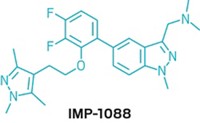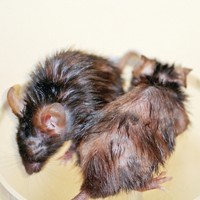Advertisement
Grab your lab coat. Let's get started
Welcome!
Welcome!
Create an account below to get 6 C&EN articles per month, receive newsletters and more - all free.
It seems this is your first time logging in online. Please enter the following information to continue.
As an ACS member you automatically get access to this site. All we need is few more details to create your reading experience.
Not you? Sign in with a different account.
Not you? Sign in with a different account.
ERROR 1
ERROR 1
ERROR 2
ERROR 2
ERROR 2
ERROR 2
ERROR 2
Password and Confirm password must match.
If you have an ACS member number, please enter it here so we can link this account to your membership. (optional)
ERROR 2
ACS values your privacy. By submitting your information, you are gaining access to C&EN and subscribing to our weekly newsletter. We use the information you provide to make your reading experience better, and we will never sell your data to third party members.
Drug Discovery
Compound prevents flu-related lung damage in mice
By inhibiting RIPK3, UH15-38 stops cell death from necroptosis
by Bethany Halford
April 10, 2024

A compound known as UH15-38 prevents mortality in mice infected with fatal doses of influenza A virus, even when it’s given up to 5 days after infection. UH15-38 inhibits receptor-interacting serine/threonine-protein kinase 3, or RIPK3, a key enzyme in the cell-killing process called necroptosis. If the compound or a similar molecule can be translated to humans, it could provide a much-needed therapeutic option for treating influenza, which causes up to 5 million cases of severe illness and as many as 650,000 deaths worldwide annually, according to the World Health Organization.
Scientists once considered RIPK3 an undruggable target, says Fox Chase Cancer Center’s Siddharth Balachandran, who led the development of UH15-38 with Alexei Degterev of Tufts University School of Medicine, Paul G. Thomas of St. Jude Children’s Research Hospital, and Gregory D. Cuny of the University of Houston. RIPK3’s sole job as a kinase is to phosphorylate a molecule called MLKL. Once MLKL becomes phosphorylated by RIPK3, it bonds with several units of itself and travels to the plasma membrane from the inside of the cell. There, it punches holes in the plasma membrane, causing the cell to take in water and explode. This process of regulated cell death is called necroptosis.
Small amounts of necroptosis can spark the body’s immune response, but if necroptosis proceeds unchecked, it can lead to lethal lung damage. Preventing RIPK3 from phosphorylating MLKL is a promising strategy for blocking necroptosis, but separate from its role in necroptosis, RIPK3 can activate the programmed cell death process known as apoptosis, in which the body kills off certain cells to prevent viral spread.
With UH15-38, Balachandran and coworkers were able to stop necroptosis without interfering in the apoptosis pathway—something that previous RIPK3 inhibitors were unable to do (Nature 2024, DOI: 10.1038/s41586-024-07265-8).
John Silke, who studies cell death and inflammation at the Walter and Eliza Hall Institute of Medical Research, says in an email that “the trick is to retain a strong antiviral response while reducing the inflammation, and this new small molecule RIPK3 inhibitor seems to thread this needle.”
Silke says he’s impressed by the fact that UH15-38 blocks serious influenza-associated lung damage even if given 5 days after infection in animal models. “This is substantially better than current anti-flu drugs like Tamiflu, which only provided protection if administered 24 hours after infection and no longer provided protection if administered 48 hours after infection,” he says.
Balachandran says that while UH15-38 works well at blocking the mouse version of RIPK3, it’s not as good at blocking the human version. “Our current efforts are focused on developing the next generation of UH15-38 analogs for human use,” he says. He and his coworkers have started a company called Vaayu Therapeutics to develop those analogs.





Join the conversation
Contact the reporter
Submit a Letter to the Editor for publication
Engage with us on Twitter